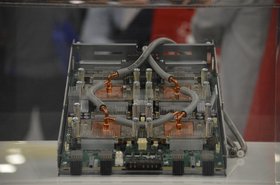Whether it a result of the natural growing population or the increased bandwidth for streaming services and working from home as a result of Covid-19 crisis, there has been a shift in demand for data centers and an increased need for server capacity. As a result, increasing server densities and chipsets operating at higher temperatures are driving a need for effective cooling solutions. Quite often, these cooling solutions rely on water.
But data center operators don’t always have the tools and expertise to optimize water usage. At a high level, there are big picture issues, like balancing sustainability and operational effectiveness. At the operational level, there are highly granular, specialized concerns, like the internal water chemistries of cooling towers.
Getting water usage right can have significant benefits. It means saving money on both water and power consumption, reducing downtime risk, and increasing the overall sustainability of the data center.
Realizing these benefits, and maintaining them over time, will likely require specialized expertise. The trends pointing in that direction are numerous.
The big picture: sustainable water use
At most data centers, there is a trade-off between water and energy consumption. The most frequent example of this happens when operators seeking to reduce power consumption switch from computer room air conditioning (CRAC) systems to evaporative cooling systems. While this tends to result in a reduction in power consumption, greenhouse gas emissions, and operating expenses, it also tends to increase water usage.
Many corporate sustainability goals have traditionally focused on energy usage over water usage. Increasingly however, communities in which data centers are located are taking a closer look at water consumption.
In many cases concern stems from the use of potable water, treated by local municipalities for the local drinking water supply. In a handful of cases, local communities have objected to the construction of new data centers because of the large amount of water they use. This is especially true in water scarce regions where a data center intends to draw from groundwater. These situations tend to be a bit more complicated because of competing concerns over resource constriction, water drawing rights, and local economic development desires.
More computing from every drop of water
Depending on location, potable water from groundwater or municipal sources can contain low levels of dissolved solids - mostly silica and salts, but the exact makeup depends on local conditions. When heat is rejected through evaporation in the cooling tower, the water vapor does not carry dissolved solids with it. Thus, the remaining water tends to have higher concentrations of total dissolved solids. Makeup water adds more dissolved solids to the system, which over time, can damage equipment or reduce efficiency of cooling. Water that is removed from the system is referred to blowdown. Cooling water blowdown can be treated and reused.
Recycling of cooling tower blowdown seems to be a natural step in the pursuit of the most environmentally balanced facility cooling solution, and it has a beneficial impact on the Water Usage Efficiency (WUE) metric. WUE measures the amount of water the facility uses per kilowatt of energy consumed. However, there can be tradeoffs with recycling cooling tower blowdown water. For example, when more water treatment equipment is added, energy usage typically increases as well, thus offsetting the gains seen in the transition to evaporative cooling.
Another solution is for data centers to work with municipalities and reduce consumption of potable water supplies by reusing treated water from within the facility, or from outside sources like treated municipal wastewater. Water reuse technologies are increasingly being employed by many companies with significant public presence. Water reuse involves using treated wastewater to replace processes where potable water had been used for cooling. To enable water reuse, data centers can build their own wastewater treatment system to treat and reuse the water, or can have a third party build, own, and operate a wastewater treatment plant to operationalize water costs. Data centers can also be sited near municipal wastewater treatment plants to better enable water reuse. For example, the Broad Run Water Reclamation Facility (BRWRF) in Loudoun County, VA - which uses SUEZ membrane bioreactor (MBR) technology to treat municipal wastewater - supplies local data centers with up to 3.5 million gallons of reclaimed water each day for cooling purposes, and has plans for expansion to accommodate data center growth in the area.
One caveat: the sustainability benefits a data center receives from the use of recycled water from outside the data center may not be included in the WUE calculation, because the WUE calculation is source agnostic.
Ultimately, deciding which treatment strategy fits the operational and capital financing structure of a project, along with its sustainability goals, involves a high number of variables that can be specific to each data center. Such decisions typically require highly detailed, granular understanding of water treatment operations.
Operational details
Complementing a reuse approach are a slew of specialized technologies that optimize water use by tweaking the chemistries of the water itself to inhibit biologic growth and control scale and corrosion These strategies tend to focus on prolonging asset life as well as minimizing water use.
For example, chemical treatment of cooling water can effectively manage the difficulties encountered from dissolved solids, and can even allow the plant to operate with higher concentrations of solids in water. Chemical treatment of cooling water can increase cycles of concentration by a factor of two or more. Other chemical treatment strategies focus on the control of biological growth inside cooling systems, and particle size inside microchannel cooling surfaces. But if not properly controlled, the chemicals themselves can lead to higher water usage.
Future growth
According to recent research published in Science journal, while computing workloads grew by a factor of five between 2010 and 2018, energy use at data centers grew by only 6 percent. This remarkable feat stems from significant gains in the energy efficiency of computing equipment and data centers alike.
Likewise, efficiency of cooling systems has been boosted by the use of economizers, locating data centers in areas to maximize “free” cooling hours, and other improvements.
These gains are by no means guaranteed. The rise of 5G, IoT, and artificial intelligence will add to what is already a significant demand for computing resources. Nobody really foresees a future with fewer mobile resources and less streaming video content.
As companies seek to build new data centers, increase the density of existing data centers, or reduce energy consumption, there will be increased demand for water solutions.
Getting the most out of a data center’s water use will require significant expertise and a holistic approach to optimize the water footprint.





